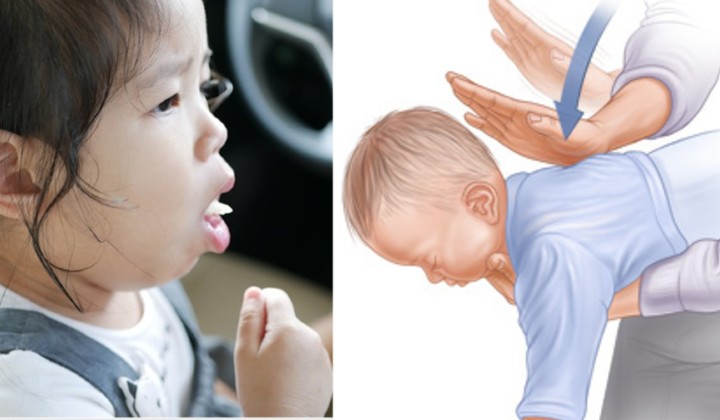Children choking; what to do and when to call an ambulance

Did you know that something as small as a small piece of bread can be lethal to a child?
Last week, a 2-year-old child was pronounced dead after choking on small pieces of bread, and it is not the first choking case we have heard in Malaysia either.
So what can be done? And how do we know if a child is choking?
These are the signs of choking in children.
Well, they are rather similar to adults actually…
1. Unable to talk or CRY
When a child is unable to express themselves, sometimes it is because their windpipes are totally obstructed.
There are also times when you can hear a loud stridor (harsh vibrating) sound.
2. Panic
A child may not be able to express themselves, but what they can do is act very frantic.
Especially if they start flailing their arms or start ‘throwing a fit‘…because they might be trying to tell you something.
3. Hold their neck and ask for help

(Pic Credit: Online First Aid)
4. Turns blue
If a child is blue, he/she is probably going to become unconscious soon.
5. Unconscious
This normally happens when a long time has passed since a child was choked.
What can we do when a child chokes?
This depends on the situation really:
We found a relatively easy flowchart to follow according to the Resuscitation Council (UK).

In a child that isn’t badly choking, he/she is most probably able to still cough.
Do:
In these cases, you should encourage a child to continue coughing on their own.
Although so, if you see a child becoming more lethargic, the child should be rushed to the Emergency Room as soon as possible or call 999.
Don’t:
DO NOT try to introduce your finger in their mouth, as you might accidentally push back the object into the throat further.
In babies (less than 1-year-old), regardless if they are conscious or not, you can try doing the Heimlich maneuver.
Try to do it for 2 minutes, if it does not help, call for help (999).
In more severe cases…
A child can be either be still conscious, or barely conscious.
In children who are still conscious but having weak coughs, you can try giving them 5 back blows followed by 5 abdominal thrusts.


It looks a bit different in children who are bigger.

In unconscious children, you should open the child’s airway to access it’s air airway to see if there is anything obstructing the airway. Ir there’s nothing, immediately start CPR.
When do we need to bring them to the doctor?
1. When your child continuously coughs, have difficulty in breathing or swallowing.
Basically, if you see your child continuously drooling, that’s a bad sign.
2. Starts turning blue
Regardless if you have found the thing your child choked on, turning even a tinge of blue is bad!
3. If you feel your child choked something dangerous
Examples would be, batteries or toys.

You know how the old saying goes, “better safe than sorryâ€?
Well here are some steps to help prevent choking from happening in children.
1. Avoid ‘high’ risk food
Some examples would be, raisins, grapes, pastilles, and nuts.
This is because they are roughly the same size as a child’s breathing pipe. So the chances of it getting stuck and obstructing a child’s breathing are high.

2. Meal etiquette
Train your child to sit up whilst eating. Also, teach them to chew and not talk/laugh during meals.
All these little things help prevent choking.
Also avoid giving your child large chunks of food at once, instead give them small bite-sized food.

3. Age appropriate toys
It is vital that children are not exposed to toys that are not appropriate, as smaller toys can easily get lodged in their nostrils or windpipes.

We hope these tips were handy to help you out in the future. Be that hero everyone needs!
Writer








